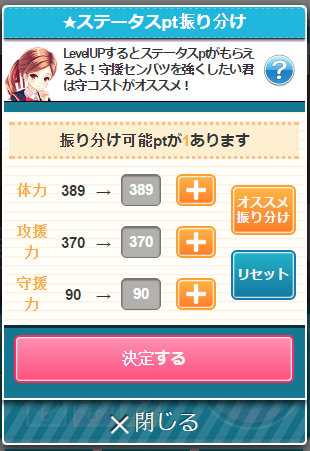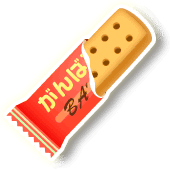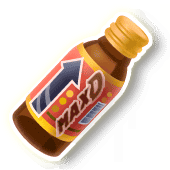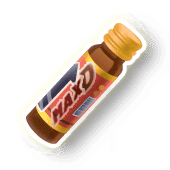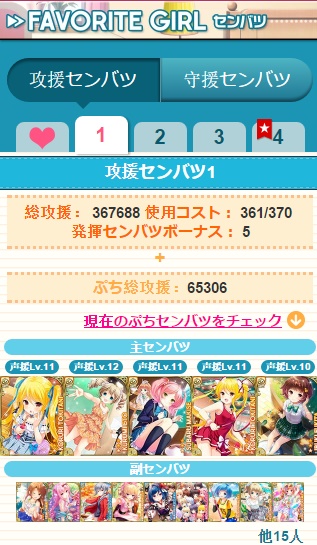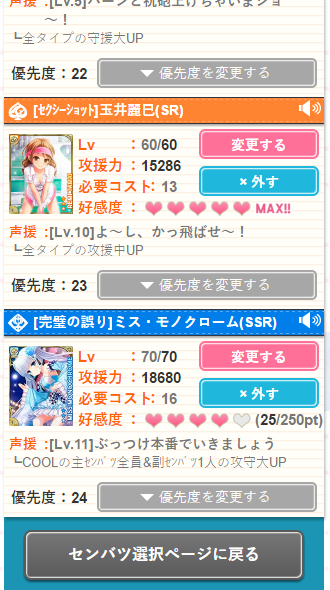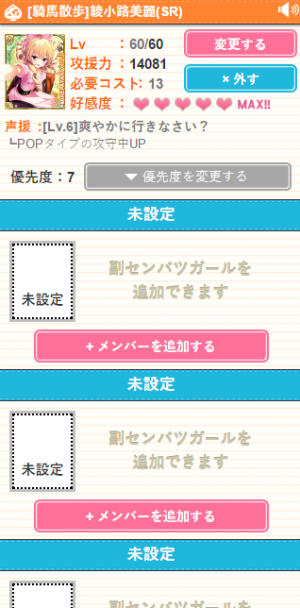Stats
Your Stats
In Girlfriend Kari, there are three stats that you, as the player, will have: Stamina (体力), Attack Cost (攻コスト), and Defense Cost (守コスト). You will initially start with only 20 points in each of the three stats, but these can be improved as you level up, or clear the morning, evening, and night sessions of the Quest/Area section in the game. You also get more stat points by adding people as friends.
If you're under level 100, you gain three points when you level up. If you're above level 100, you gain only two points when you level up. You gain one point for clearing each section of the Quest/Area mode (when the blue bar fills up at the top and takes you to another part of the day or the next day). You also gain five points when you become friends with another player. However, when you unfriend a person, you lose five points off of your highest stat.
These points, of course, can be used to improve your Stamina, Attack Cost, and Defense Cost.
Stats
Stamina (体力)
Stamina is consumed when Questing or participating in Quest-like activities. One stamina is recovered every three minutes. Thus, 20 stamina is recovered every hour
Adding stat points into stamina allows the player to go questing for longer periods at a time, which is very beneficial to many event types as most of them have some sort of quest-like area where stamina is used to accomplish certain tasks. A larger stamina count also increases the effectiveness of stamina recovery items. Work Hard Bar (がんばるんバー) replenishes 100% stamina while Half Work Hard Bar (ハーフがんばるんバー) replenishes 50% stamina. Pictures of these items are shown below.
Attack Cost (攻コスト) / Defense Cost (守コスト)
Attack cost is used when using an attack deck, and defense cost is used when using a defense deck. In general, having more points in attack cost will increase overall attack power, and more points in defense cost will increase overall defense power. However, power is ultimately limited by the maximum number of cards available for use per deck.
One attack cost is recovered every 30 seconds. Attack can be recovered fully by using Bottles (元気炭酸), and 50% attack cost can be replenished using Half Bottles (ハーフ元気炭酸). Defense cost never needs to be replenished. It will always be at max, as the stat cannot be manually used - it is only used when other players are attacking you, which you have no control over. Pictures of these items are shown below.
There are two different types of decks - one type for attack and one type for defense. When placing cards into an attack deck, the attack stat of the card will be used to determine the attack power. When placing cards into an defense deck, the defense stat of the card will be used to determine the defense power. The defense stat of a card will do nothing in the attack deck. Vice versa, the attack stat of a card will do nothing in the defense deck.
Remember that every card in the game has a cost associated with it. Cost is directly correlated with overall power (attack stat of the card + defense stat of the card) of the card. The higher the cost, the stronger the card. Every deck also has a cost, which is the sum of the cost of all the cards within that deck. For example, if you have three SR cards of cost 14, 12, and 15 respectively in your attack deck, the cost of that attack deck will be 41. If you have three SR cards of cost 11, 12, and 13 in your defense deck, the cost of that defense deck will be 36.
The attack cost and defense cost stat are both used whenever you use a deck, but function differently since attack cost is used for the attack deck, while defense cost is used for the defense deck. Whenever the attack deck is used, the cost of the attack deck will be drained from the player's attack cost stat. Whenever the defense deck is used, the cost of the defense deck will be drained from the player's defense cost stat. The attack deck is used when attacking, while the defense deck is used when defending. When you attack a player, your attack deck will battle against the opposing player's defense deck. Similarly, if someone attacks you, your defense deck will defend against the opposing player's attack deck.
You cannot use a deck that costs more than your current attack/defense cost. For example, if you try to use an attack deck that has a cost of 300 but you only have 284 attack cost, you will be unable to use that deck, and will have to choose a different attack deck. But, if you use a deck that has a cost of 274, you'll be left with 10 attack cost remaining after the battle.
As more cards are placed into the deck, as well as higher cost cards (meaning more powerful cards) replace weaker cards, the overall cost of the deck goes up. This means that generally, as a deck gets stronger, the cost of that deck increases. To use that deck, the cost of the deck must be drained from the respective attack/defense cost stat. Thus, a higher attack/defense cost stat means that the player will be able to use more powerful decks. However, the amount of cards that can be used in a deck is limited to prevent a deck from growing infinitely powerful. This is explained below.
Attack/Defense Cost Limitations
The sections on attack/defense cost limitations is fairly advanced, and should not be the concern of players under level 70.
For deck making, five cards can be used in the main selection, and a varying number of cards can be used in the vice selection. The number of cards that can be used in vice selection will increase as the player levels up (generally one more card slot is gained every ten levels). You can check your available vice selection slots by going to your deck (センバツ), modify (編集する) one of the decks that is not the auto-generated deck (one with a number on the tab), click on Vice Selection (副センバツ) at the top tab and see how many slots you have available for use.
In short, there is always a limit to the maximum number of cards that a deck can contain. The limit can be increased by leveling up and through some other methods.
Thus, in order to improve attack or defense power while using points efficiently, a balance between attack/defense cost and the amount of available card slots should be kept.
If not enough points are put into attack/defense cost, stronger decks that fill up all card slots with high cost cards that the player wants to be used in the deck may cost too much to be used. Thus, there will end up being unused card slots or card slots occupied by very low cost cards with very weak stats in decks that the player can use, which limits the power of the deck. Once the attack/defense cost stat is raised, more powerful decks that utilize the remaining card slots and utilize higher cost cards (stronger cards) can then be used.
Now, if too many points are put into attack/defense cost, there will be leftover attack/defense cost points that cannot be used. Once the player has filled all card slots available with the strongest cards available, the deck has reached its maximum strength and cannot be improved for the time being. The deck's cost will also not increase, since no more cards can be added to the deck, and no stronger cards (cards with a higher cost) exist - since it is already the strongest deck currently available! The remaining points are leftover after the deck is used, and are generally wasted until the user either obtains stronger cards with a higher cost, or more vice selection card slots. Those points may have been more useful if placed into a different stat, such as stamina.
However, there are some uses to having more attack cost than the cost of the strongest attack deck. Having a lot of attack cost may allow you to use a deck multiple times without having to replenish attack cost. This is called "Attack Cost Overflow", and is explained later below, but is a very advanced topic and generally useless, as it is usually weaker than attacking with one strong deck, and is only applicable for some very specific situations.
Example of Limitation
An example of how card slots can limit your attack cost from being fully used is shown below.
Note: for the example below, a few assumptions are being made. In actuality, cards in your vice selection are weaker than cards in your main selection - cards in vice selection will only have 80% of their original stats when used in attack or defense. However, for the sake of simplicity, this is being ignored, and we are assuming that cards in vice selection can use 100% of the card's original stats. Senbatsu bonuses are also being ignored, since that is significantly more complex and will be covered in another page.
Let's say you're level 50 and have 5 card slots available in your main selection, and 5 slots available in your vice selection. You want to build a good attacking deck! Let's say you have 10 cards that you want to use in your deck - every card just so happens to be a 12 cost HR (high-rare) card with attack 13,500. These are your strongest cards. You also have a few N (normal) cards of cost 2, but are significantly weaker than the HR cards (attack: 1000).
So, the ideal situation is that you are able to use all 10 of these HR cards. This would mean your ideal base attack is 13,500 * 10 = 135,000. In order to use all these cards, you'll need an attack cost of 12 * 10 = 120.
So, if you have 120 attack cost, then you can use all ten of your strongest cards (the ten HR cards, each of 12 cost), which is exactly what you wanted to do.
But now, what if you only have 110 attack cost? Well, you can't use all ten of your 12 cost cards - you don't have enough attack cost for it! Thus, you'll only be able to use nine of those 12 cost cards, leaving you with one leftover vice selection slot! Since you still have ten attack cost left, you can fill that remaining slot with that N rarity card you had of cost 2. This means your base attack is weaker now - it's 13,500 * 9 + 1000 = 122,500!
What if you only have 60 attack cost? Well, now you can only use five of your 12 cost cards - which is already 60 cost, meaning you can't do anything else afterwards! That means your attack is even weaker now - 13,500 * 5 = 67,500! You also have 5 empty card slots that aren't being used!
In the last two situations, we've shown that if you put more points into your attack cost, you would be able to easily become stronger by being able to place more cards (or more stronger cards) into your deck by using empty card slots or card slots occupied by super weak low-cost cards.
What happens, however, if you go over 120 attack cost? What if you have 150 attack cost? Well, first we want to use our strongest cards - the ten HR cards of 12 cost - which uses up 120 of our attack cost. This leaves us with 30 leftover attack cost - but we don't have any more card slots that we can use to add more cards! This means we have 30 attack cost leftover! This isn't enough points to do anything with for now, and you can't power up your deck more because you're out of stronger cards and card slots. Now, usually you gain another card slot every ten levels, so at level 60, you'll be able to use another card to use some of that leftover attack cost. But in the meantime, those points would have been of more use if they were placed into another stat, like stamina!
Thus, in order to maximize your attack/defense decks most efficiently, the goal is to increase your attack/defense cost to match up with the available card slots, and the cost of the cards that you will be using. For beginning players, you can estimate that you will be using roughly 12 cost per card slot. For intermediate/advanced players, you can estimate ~15 cost per card slot. Of course, this number will vary depending on the cards that you plan on using, and the bonuses that you want to add to your current attack and defense power.
What kinds of cards should you use in your deck to maximize bonus power? Well, that's a different topic which will be covered in a different article. But for now, you should understand how Attack Cost and Defense Cost are used in conjunction with your available Vice Selection Card Slots to determine your base attack and base defense power.
Benefits of Attack Cost Overflow
This is a highly advanced topic that should definitely not be the concern of users under level 70.
Having more attack cost than the cost of the strongest deck available has a few uses. For starters, it decreases the amount of time necessary to wait until the attack cost has regenerated enough such that the deck can be used again.
Furthermore, a high attack cost that disregards the cost of the strongest deck available can allow players to use weaker decks when battling against weaker players (or enemies in some event types) multiple times without having to refill the attack cost stat. Weaker decks have a lower cost, which means less attack cost will be drained when using that weaker deck. Having a high attack cost can then allow the player to use that weaker deck multiple times without having to replenish the attack cost stamina. This allows the player to easily take down weaker enemies/players without having to deplete their entire attack cost gauge at once. This is useful in events such as club cups (when trying to score as many victories as possible).
For example, if you have 350 attack cost, and have a deck that costs 110 that you want to use against some weak opponents (who have a defense deck of, lets say, 20 cost). You can thus use that 110 cost attack deck three times without having to refill your attack cost, since 3 * 110 = 330, which still leaves you with 20 attack cost remaining after three attacks.
However, in general, players should still strive to balance attack cost with the number of vice selection card slots available for maximum efficiency, as these techniques are only viable in a few event types. By late game (advanced players of either stamina-focused or offensive type), most players will naturally have enough attack cost to attack weaker opponents using weaker decks multiple times. Also, one strong deck that costs a lot will almost always do more damage than multiple attacks from a lower-costing deck. This is because of deck bonuses - which are easier to obtain the more cards your deck contains (which in turn, means higher cost).
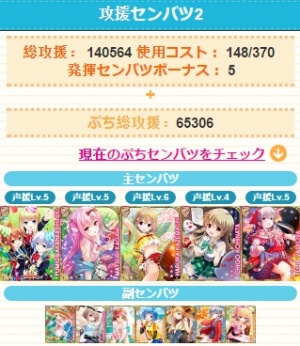
These techniques do not apply to defense cost, as defense cost cannot be manually used, and is always at maximum.
Note that the game does not allow players to use decks with a cost under 100 when the auto-generated deck has a cost above 100.
Warning about Attack/Defense Cost
Many events disregard the attack/defense cost calculation described here, and rather use other systems of calculating attack power. For example, the raid event uses 25% of your attack cost whenever you attack, and calculates your attack power differently (but still based on your main deck). This value is fixed and does not change.
Stat Advice
In general, the most important stats in this game are Stamina and Attack. These are the main stat types used during the events, so prioritizing these stats will allow you to perform better in events, leading you to obtain event rewards easier. Defense stat is rarely used in events, but is important to have for those who wish to become defenders in a club. Having dedicated defenders in a club makes it more difficult for the club to be defeated in club cup events, and provides for additional bonuses. However, because defense does not help much for other event types, defense is mostly for advanced players (players who usually have another account focused on events) to serve as defending players in their clubs.
Thus, for new players, most, if not all, newly gained points should go into either Stamina and Attack for maximum performance during events.
Types of Players
There are generally four main types of players in this game.
Balanced Player
This type of player puts equal amounts of points into each stat. This can be achieved through using the Automatic Assignment Button (自動で割り振る). This is a player who is good in everything; attacking, defending, and questing. You should first raise your Stamina and Attack Cost. After reaching a good amount of Attack Cost, increase your Defense cost.
This type is generally not recommended, because the defense stat will not be high enough to deter other players from attacking a balanced player, which ultimately leads to a lot of wasted points in defense.
Stamina-Focused Player
Putting a lot of skill points into Stamina allows the player to level up very quickly. This type of player profits a lot from Ganbaru Bars (がんばるんバー) and perform well in story events, or other events that depend solely on stamina. Stamina is also universal to almost all event types (it's almost always used one way or another), so having a large stamina will always help. These players usually have twice as much stamina as they do attack (which means they generally end up with card slots unused), and will usually put little or no points into defense.
Usually, a Stamina-Focused player will start off balancing both stamina and attack, until both stats reach 100. Then, they focus more onto stamina than attack.
This type of player is recommended for new players, along with the offensive type, as both types perform well in events, making it easier to obtain event rewards and new cards.
Offensive Player
An offensive player primarily increases their Attack Cost and Stamina the most. Because of that, they are good in raid events and other attacks that require strong attack, where they can profit well from consuming energy drinks to attack enemies with devastating power. However they will be at a disadvantage in class battles because they will be easily defeated by the enemy team. These players usually put as much points into attack as their card slots allow them to, and will dump the rest into stamina. Little or no points should be put into defense.
Usually, an offensive player will start off balancing both Stamina and Attack, until both stats reach 100. Then, they put more points into attack until they are able to use all their vice selection card slots with the cards they want (usually account for ~13 cost per card if an intermediate player, and ~16 cost per card if a more advanced player). Make sure to modify the attack deck rather than the defense deck.
This type of player is recommended for new players, along with the stamina-focused type, as both types perform well in events, making it easier to obtain event rewards and new cards.
Some offensive players go full into attack, dumping as many points as they can into attack so that they can get multiple strong attacks out of their decks. This is not recommended for new players, as it makes it difficult to perform questing activities in events with a low amount of stamina.
Defensive Player
Defensive players focus on raising their Defense Cost. However, these players shouldn't avoid putting points into Stamina or Attack Cost or else they won't be able to do anything. This type of player is very important for clubs to defend them in tournament events. They should usually be promoted to Defense Captains.
These players will usually start off balancing both Stamina and Defense, until both stats reach 100. Then, they put more points into defense until they are able to use all their vice selection card slots with the cards they want (usually account for ~13 cost per card if an intermediate player, and ~16 cost per card if a more advanced player). Make sure to modify the defense deck rather than the attack deck. Some points should also be placed into attack so that the player is not completely useless during events.
This type is not recommended for beginners, as performing in events and obtaining event rewards becomes very difficult without a good attack stat. This type of player is useful to clubs, and is usually created as a second account by another player with more experience with the game already.
